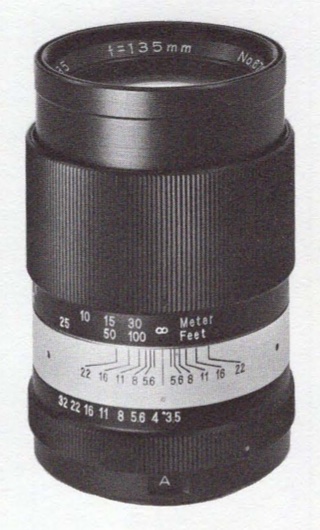Vivitar Auto 135mm F/3.5 "Bright Band"
Medium telephoto prime lens • Film era • Discontinued
Specification
| Optical design: | |
| 35mm full frame | |
| 135mm | |
| F/3.5 | |
| 4 elements in 3 groups (Sonnar) | |
| Canon FL [42mm] | |
| Exakta [44.7mm] | |
| M42 [45.5mm] | |
| Minolta SR [43.5mm] | |
| Nikon F [46.5mm] | |
| 18.2° (35mm full frame) | |
| On Nikon D APS-C [1.53x] cameras: | |
35mm equivalent focal length: | 206.6mm (in terms of field of view) |
35mm equivalent speed: | F/5.4 (in terms of depth of field) |
Diagonal angle of view: | 12° |
| Diaphragm mechanism: | |
Diaphragm type: | Automatic |
Aperture control: | Aperture ring (Manual settings only) |
| 6 (six) | |
| Focusing: | |
| 1.50m | |
| <No data> | |
Focusing modes: | Manual focus only |
Manual focus control: | Focusing ring |
| Physical characteristics: | |
| 450g (mount not specified) | |
| ⌀?×95mm (mount not specified) | |
| Accessories: | |
| Screw-type 52mm | |
| Built-in telescopic round | |
| <No data> |
Sources of data
- Vivitar Wide Angle, Telephoto, and Zoom Lenses for 35mm SLR Cameras booklet (May 1968).
- Exakta system: 35mm photography. 35 years of leadership booklet (May 1968).
From the Camera magazine (April/May 1970)
Lens #4092041
If the photographer is willing to sacrifice one element, two-thirds of an f-stop, an increase of one-half inch in length (and save $34.00), he can still have a good quality 135mm lens. Again, resolution figures don't give the whole story. This "slower" lens was capable of making remarkably clear and sharply defined images that held together in all but extreme enlargements (would you believe 30x40 inches?). Focusing was smooth and easy, and, as with all the Auto Vivitar lenses, this one couples to the built-in meter of the camera in use. An excellent all-round lens for large head shots and for moderate telephoto work, the 135mm f/3.5 proved to be a capable performer. Some flare at maximum aperture caused slight loss of resolution, but definition improved as the lens closed down.
Notes
- Independent-brand lenses were made for 35mm film SLR cameras by companies that competed with the camera manufacturers. Some came from factories that made lenses under their own brand names (Angenieux, Kiron, Sigma, Tamron, Tokina). Many others were national and international marketing organizations (Kalimar, Panagor, Rokunar, Soligor, Starblitz) that bought lenses from anonymous manufacturers. One firm — Vivitar — actually designed its own lenses and accessories, which were then subcontracted to manufacturing firms. Still others were private labels, sold only by specific photo specialty shops (Cambron, Quantaray, Spiratone).
- The actual manufacturer of a Vivitar lens can be identified by the first digits of the serial number: 09 - Cosina, 13 - Schneider-Kreuznach, 19 - Sigma, 22 - Kino Precision Industries, 25 - Ozone Optical, 28 - Komine, 32 - Makina Optical, 33 - Asanuma, 37 - Tokina, 42 - Eugen Bauer, 44 - Perkin Elmer, 47 - Chinon, 51 - Tokyo Trading, 56 - Kyoe Shoji, 61 - Samyang, 6x - Olympus, 75 - Hoya, 77 - Kobori, 81 - Polar, 9x - Cosina. This numbering system, however, was used by Vivitar only between 1969 and 1991 (approx.).

